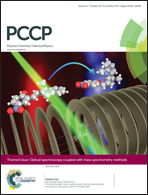On the non-classical contribution in lone-pair–π interaction: IQA perspective†
Abstract
In the present work the nature of lone-pair–π interactions between water molecules and a number of π-rings with different substituents/hetero-atoms in the light of quantum chemical topology approaches is studied. The Quantum Theory of Atoms in Molecules (QTAIM) and Interacting Quantum Atoms (IQA) were employed for distinguishing the role of heteroatoms and electron withdrawing substituents in the complex formation between water and π-rings. Our IQA study identified three classes of water–π complexes on the basis of the relative role of electrostatics (classical) and exchange–correlation (non-classical) factors in the interaction energy between the oxygen of water (the lone-pair donor) and the sp2 atoms of the π-ring, i.e. the primary lp–π interaction. Considering both the primary and secondary (the rest of interatomic interactions except Owater–π-ring atoms) interactions demonstrates that the exchange–correlation is the dominant contributor to the binding energy. This proves a non-negligible contribution of non-classical factors in the stabilization of the lone-pair–π complexes. However, in spite of a relatively large contribution of the exchange–correlation, this part of the interaction energy is virtually counterbalanced by the deformation energy, i.e. the increase in atomic kinetic energy upon complexation. This finding clarifies why water–π interactions can be modelled by simple electrostatics without the need to invoke quantum effects.



 Please wait while we load your content...
Please wait while we load your content...